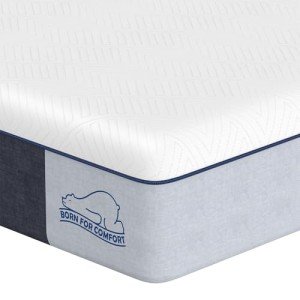An Intermediate Guide The Steps To Motion Isolation Memory Foam Mattress
Motion Isolation Memory Foam Mattress: The Ultimate Guide
In recent years, the demand for high-quality sleep has actually risen, causing innovations in sleep technology and convenience. Among these innovations is the motion isolation memory foam mattress, an item that has actually changed the way individuals view convenience and sleep quality. This post delves into the performance, advantages, and considerations of motion isolation memory foam mattresses, assisting readers make notified options about their sleep environment.
What is Motion Isolation?
Motion isolation describes the capability of a mattress to absorb movement, thus avoiding it from transferring throughout the surface area. This feature is especially useful for couples, where the movements of one partner can interrupt the other's rest. Understanding how different mattress types perform in this location is vital for those seeking a serene night's sleep.
How Motion Isolation Works in Memory Foam Mattresses
Memory foam mattresses are designed to contour to the body, providing assistance and convenience. The special homes of memory foam are main to effective motion isolation:
Viscoelastic Material: The viscoelastic product in memory foam responds to pressure and heat. When weight is applied, the foam compresses and takes the shape of the body. This particular assists in minimizing the transfer of movement across the mattress.
Damping Effect: When one side of the mattress is disturbed (for example, when one partner gets up or shifts positions), the foam's damping result absorbs the shock, minimizing the impact felt on the other side of the bed.
The outcome is a mattress that enables one person to move without significantly disturbing the other, making it a popular choice for couples or light sleepers.
Advantages of Motion Isolation Memory Foam Mattresses
1. Peaceful Sleep Environment
One of the most significant benefits of a motion isolation memory foam mattress is its capability to produce a tranquil sleep environment. Couples who wake each other up from motions can benefit significantly from this function.
2. Pressure Relief
Memory foam is renowned for its pressure-relieving abilities. It complies with the body, helping ease pressure points on the shoulders, hips, and back, which can lead to improved sleep quality.
3. Spine Alignment
The capability of memory foam to contour to the body's natural curves promotes healthy spine alignment. Proper alignment lowers the danger of pain and long-lasting back problems.
4. Resilience
High-quality memory foam mattresses are designed to last in time, supplying both convenience and assistance. Numerous manufacturers use extended guarantees, suggesting their confidence in the item's toughness.
5. Hypoallergenic Properties
Memory foam is resistant to allergen and irritants, making it an outstanding choice for individuals with allergies or breathing concerns. This feature adds to a healthier sleeping environment.
Disadvantages of Motion Isolation Memory Foam Mattresses
1. Heat Retention
Some memory foam mattresses may retain heat, causing discomfort for those who tend to sleep hot. Many more recent models include cooling innovations, but it stays a consideration when picking a mattress.
2. Weight
Memory foam mattresses can be heavier than other mattress types, making them challenging to move or change without support.
3. Expenditure
High-quality memory foam mattresses can be more costly than conventional spring mattresses. However, the investment might be beneficial when thinking about durability and sleep quality.
Selecting the Right Motion Isolation Memory Foam Mattress
When choosing a motion isolation memory foam mattress, a number of aspects need to be considered:
1. Density and Firmness
- Density: Higher density foam might supply much better motion isolation and durability. Nevertheless, it might likewise feel firmer.
- Firmness Level: Consider individual convenience preferences. A medium to medium-soft firmness is often recommended for couples.
2. Cooling Features
If heat retention is an issue, look for mattresses with cooling gel layers, breathable covers, or open-cell foam styles.
3. Trial Period and Warranty
Lots of trusted manufacturers use trial periods and service warranties. A trial period allows potential purchasers to check the mattress in the house, while a warranty supplies peace of mind concerning durability and craftsmanship.
4. Evaluations and Recommendations
Checking out customer evaluations and seeking recommendations can provide insight into the mattress's efficiency, specifically relating to motion isolation and total convenience.
Frequently Asked Questions (FAQs)
1. Do all memory foam mattresses have motion isolation properties?
While many memory foam mattresses supply some level of motion isolation, the degree varies amongst various designs. Higher-density foams typically offer better efficiency.
2. How do I know if a memory foam mattress is best for me?
Consider your sleeping position, any existing pain (like neck and back pain), and your personal comfort preferences. Evaluating mattresses in-store or using trial durations can assist you find the best fit.
3. Can I utilize a memory foam mattress on any bed frame?
Many memory foam mattresses can be utilized on different bed frames, including platform beds, slatted frames, and adjustable bases. Ensure the frame offers appropriate support to keep the integrity of the mattress.
4. How typically should I replace my memory foam mattress?
Memory foam mattresses usually last between 7 to 10 years. Inspect for signs of wear and tear, such as sagging or lumps, to figure out when it's time for a replacement.
A motion isolation memory foam mattress is an excellent financial investment for those in search of a restful and undisturbed night's sleep. With its ability to decrease motion transfer, offer pressure relief, and promote correct spinal column positioning, it deals with various sleep-related concerns. By considering Gel Memory Foam Mattress detailed in this guide, prospective purchasers can make educated choices and enjoy the complete benefits of this innovative sleep technology.
Benefits
Downsides
Tranquil sleep environment
Heat retention
Pressure relief
Much heavier than other types
Promotes spine positioning
Greater preliminary cost
Resilience
Differs with quality
Hypoallergenic residential or commercial properties
As sleep continues to play an essential function in overall health and wellness, financial investments in quality mattresses like motion isolation memory foam alternatives are more appropriate than ever.
